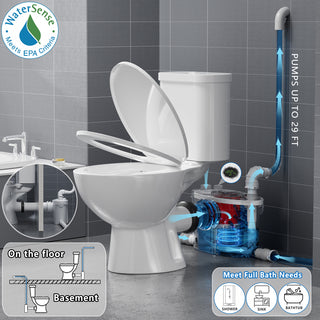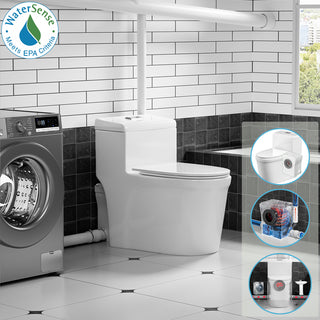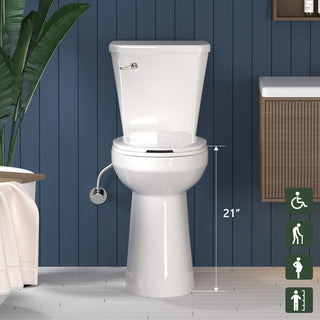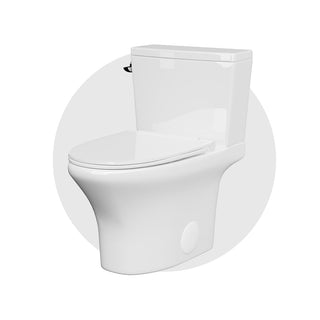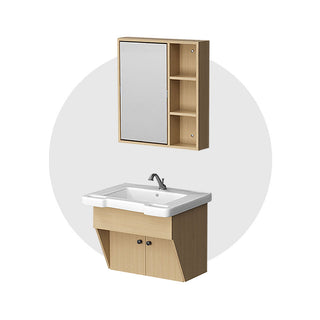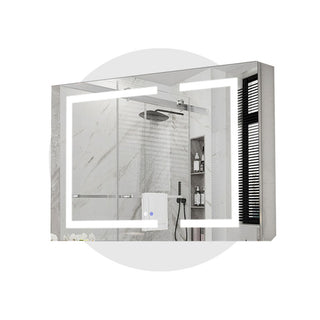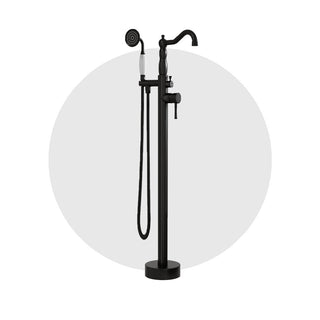Toilet is an indispensable bathroom product in our daily life. A practical and beautiful toilet not only reduces the frequency of cleaning, but also enhances the overall style of the bathroom. Toilets on the market are mainly divided into two types of tanks and tankless, which differ significantly in design and function. Therefore, when shopping must be clearly understood in advance, or use only to find that it is not suitable, it is too late.

Traditional toilets are usually equipped with a water tank, while some smart toilets have the tank cleverly hidden behind the toilet seat. In this article, we will compare the advantages and disadvantages of the tankless toilet and the toilet with tank, hoping to provide some valuable reference for you to buy a toilet!
Toilets with tanks have the following advantages and disadvantages:
 Advantages:
Advantages:
A. No Worry About Water Pressure
Toilets with a tank don’t require high water pressure. After each flush, the tank automatically refills, storing water for the next use. Even if your home has low water pressure, it will only affect the refilling time, not the flushing power. This makes it convenient for those who are unsure about their water pressure or concerned about it being too low, saving them from the hassle!
 B. Consistent Flushing Power
B. Consistent Flushing Power
With the tank always maintaining a sufficient water supply, the flushing power remains stable every time, unaffected by low water pressure. Typically, one flush is enough to clean effectively, without the need for multiple flushes, helping to prevent water wastage. Additionally, some toilets offer two flush options, contributing to water conservation.

C. Easy to Clean
Traditional tank toilets are very easy to clean—just rinse with water, and there's no worry about leaks or electrical issues. On the other hand, smart toilets require electricity to function, so if water gets in, it could cause damage. Therefore, extra caution is needed when cleaning smart toilets.

Disadvantages
A. Basic Style
Traditional tank toilets tend to have a more basic design due to the protruding tank at the back. Compared to smart toilets, they don't fully satisfy aesthetic needs. However, smart toilets with a tank are different—they have a sleek, minimalist design and often look just like tankless models, making it difficult to tell whether they have a tank or not. Therefore, it's important to confirm this before making a purchase.
B. The water tank is easy to dirty
Since the tank stores water over time, it can accumulate mineral deposits and stains, which may weaken the flushing power. Additionally, bacteria can grow inside. To maintain optimal performance, the tank needs regular cleaning.
C. Limited Water-Saving Benefits
With a tank toilet, the water volume per flush is fixed. If the first flush doesn't clean properly, the subsequent flushes still use the same amount of water, leading to waste. Moreover, after each flush, you need to wait for the tank to refill before flushing again; otherwise, the flushing power may decrease.
A tankless toilet is connected directly to tap water for flushing. Compared with a tank toilet, it has the following advantages and disadvantages:
Advantages:
A. Significant Water Savings
Tankless toilets use technologies like swirl siphon and vacuum flushing, consuming less water and greatly conserving water resources. Studies show that traditional tank toilets use 6 to 9 liters per flush, while tankless toilets only use 1 to 4 liters, making the water-saving effect quite remarkable.

B. Cleaner and More Hygienic
The lack of a tank prevents the buildup of scale and stains, reducing the risk of bacterial growth and eliminating the need for regular tank cleaning. As long as water pressure is sufficient, tankless toilets offer more powerful flushing and come with features like sterilization and antibacterial functions, keeping the toilet clean and hygienic for a better user experience.
C. Sleek and Modern Design
Tankless toilets feature a sleek and minimalist design that complements various interior styles, aligning with modern aesthetic preferences. They also enhance the overall look of your bathroom, giving it a more sophisticated feel.
Disadvantages
A. High Water Pressure Requirement
Since a tankless toilet doesn't have a water storage tank, it requires high water pressure to function properly. Without sufficient water pressure, the flushing power can be compromised, leading to inadequate cleaning, especially for stubborn stains. Even multiple flushes might not do the job, and you might end up having to scrub manually.
Before choosing a tankless toilet, be sure to test your water pressure to ensure it meets the necessary standards. If your water pressure is low, you can consider installing a booster pump to improve it.
B. Louder Noise
Tankless toilets tend to be noisier when flushing because of the higher water pressure and stronger flushing power. The resulting noise may be too much for those sensitive to sound. If you prefer a quieter bathroom experience, this could be a consideration.
C. Inability to Flush During Power Outages
Many tankless toilets, particularly the smart models, require electricity to operate. If there's a power outage, you may find that the flushing function doesn't work, and you'll need to flush manually. In this case, a traditional toilet might be more reliable during power cuts.
Choosing the right toilet greatly impacts your comfort and daily life. We've covered the pros and cons of both tank and tankless toilets based on personal experiences. Ultimately, the best choice depends on your specific needs and the condition of your home. Take your time to consider all factors before making a decision, and choose what suits your lifestyle the best.


